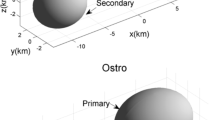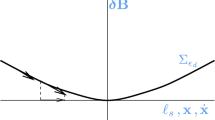Abstract
Purpose: The 1:1 spin-orbit resonance phenomenon is widely observed in binary asteroid systems. We aim to investigate the intrinsic dynamic mechanism behind the phenomenon under the coupled influence of the secondary’s rotation and orbital motion. Methods: The planar sphere–ellipsoid model is used to approximate the synchronous binary asteroid. The Lindstedt–Poincaré method is applied on the spin-orbit problem to find its explicit quasi-periodic solution. Results: Numerical simulations demonstrate that analytical solutions truncated at high orders are accurate enough to describe the orbital and rotational motions of the synchronous binary asteroid. With the help of the solution, we are able to identify in a more accurate way the stable region for the synchronous state by using the Lyapunov characteristic exponent. Moreover, the resonances that determine the boundary of the stability region are identified. Conclusion: The stable synchronous state requires a small eccentricity \(e\) of the mutual orbit but permits a large libration angle \(\theta \) of the secondary. The anti-correlation of \(\theta \) and \(e\) is confirmed. The stable region for a very elongated secondary is small, which helps explain the lack of such secondaries in observations (see Table 1 in Pravec et al. in Icarus 267:267–295, 2016). Findings of this study provide insights into the inherent dynamics that determine the rotational states of a synchronous binary asteroid.








Similar content being viewed by others
References
Antognini, F., Biasco, L., Chierchia, L.: The spin–orbit resonances of the solar system: a mathematical treatment matching physical data. J. Nonlinear Sci. 24, 473–492 (2014). https://doi.org/10.1007/s00332-014-9196-7
Bellerose, J., Scheeres, D.J.: Energy and stability in the full two body problem. Celest. Mech. Dyn. Astron. 100(1), 63–91 (2008). https://doi.org/10.1007/s10569-007-9108-3
Breiter, S., Melendo, B., Bartczak, P., et al.: Synchronous motion in the Kinoshita problem. Application to satellites and binary asteroids. Astron. Astrophys. 437, 753–764 (2005). https://doi.org/10.1051/0004-6361:20053031
Calleja, R., Celletti, A., Gimeno, J., et al.: KAM quasi-periodic tori for the dissipative spin–orbit problem. Commun. Nonlinear Sci. Numer. Simul. 106, 106,099 (2022). https://doi.org/10.1016/j.cnsns.2021.106099
Celletti, A.: Construction of librational invariant tori in the spin-orbit problem. Z. Angew. Math. Phys. 45, 61–80 (1994). https://doi.org/10.1007/BF00942847
Celletti, A., Chierchia, L.: Measures of basins of attraction in spin-orbit dynamics. Celest. Mech. Dyn. Astron. 101(1–2), 159–170 (2008). https://doi.org/10.1007/s10569-008-9142-9
Chappaz, L., Howell, K.C.: Exploration of bounded motion near binary systems comprised of small irregular bodies. Celest. Mech. Dyn. Astron. 123, 123–149 (2015). https://doi.org/10.1007/s10569-015-9632-5
Chen, H.: Capacity of sun-driven lunar swingby sequences and their application in asteroid retrieval. Astrodynamics 7(3), 315–334 (2023). https://doi.org/10.1007/s42064-023-0161-9
Compère, A., Lemaître, A.: The two-body interaction potential in the STF tensor formalism: an application to binary asteroids. Celest. Mech. Dyn. Astron. 119, 313–330 (2014). https://doi.org/10.1007/s10569-014-9568-1
Daly, R.T., Ernst, C.M., Barnouin, O.S., et al.: Successful kinetic impact into an asteroid for planetary defence. Nature 616(7957), 443–447 (2023). https://doi.org/10.1038/s41586-023-05810-5
Dermott, S.F., Li, D., Christou, A.A., et al.: Dynamical evolution of the inner asteroid belt. Mon. Not. R. Astron. Soc. 505, 1917–1939 (2021). https://doi.org/10.1093/mnras/stab1390
Gkolias, I., Celletti, A., Efthymiopoulos, C., et al.: The theory of secondary resonances in the spin–orbit problem. Mon. Not. R. Astron. Soc. 459, 1327–1339 (2016). https://doi.org/10.1093/mnras/stw752
Goldreich, P., Peale, S.: Spin orbit coupling in the solar system. Astrophys. J. 71, 425 (1966). https://doi.org/10.1086/109947
Goldreich, P., Sari, R.: Tidal evolution of rubble piles. Astrophys. J. 691, 54 (2009). https://doi.org/10.1088/0004-637X/691/1/54
Hou, X., Scheeres, D.J., Xin, X.: Mutual potential between two rigid bodies with arbitrary shapes and mass distributions. Celest. Mech. Dyn. Astron. 127, 369–395 (2017). https://doi.org/10.1007/s10569-016-9731-y
Jacobson, S.A., Scheeres, D.J.: Dynamics of rotationally fissioned asteroids: source of observed small asteroid systems. Icarus 214, 161–178 (2011a). https://doi.org/10.1016/j.icarus.2011.04.009
Jacobson, S.A., Scheeres, D.J.: Long-term stable equilibria for synchronous binary asteroids. Astrophys. J. Lett. 736, L19 (2011b). https://doi.org/10.1088/2041-8205/736/1/L19
Jacobson, S.A., Scheeres, D.J., McMahon, J.: Formation of the wide asynchronous binary asteroid population. Astrophys. J. 780(1), 60 (2014). https://doi.org/10.1088/0004-637X/780/1/60
Jorba, A., Masdemont, J.: Dynamics in the center manifold of the collinear points of the restricted three body problem. Phys. D, Nonlinear Phenom. 132, 189–213 (1999). https://doi.org/10.1016/S0167-2789(99)00042-1
Laskar, J.: The chaotic motion of the solar system: a numerical estimate of the size of the chaotic zones. Icarus 88, 266–291 (1990). https://doi.org/10.1016/0019-1035(90)90084-M
Laskar, J., Froeschlé, C., Celletti, A.: The measure of chaos by the numerical analysis of the fundamental frequencies. Application to the standard mapping. Phys. D, Nonlinear Phenom. 56, 253–269 (1992). https://doi.org/10.1016/0167-2789(92)90028-L
Li, B.S., Hou, X.Y.: The main problem of lunar orbit revisited. Astron. J. 165, 147 (2023). https://doi.org/10.3847/1538-3881/acbafa
Li, X., Scheeres, D.J., Qiao, D., et al.: Geophysical and orbital environments of asteroid 469219 2016 HO3. Astrodynamics 7(1), 31–50 (2023). https://doi.org/10.1007/s42064-022-0131-7
Margot, J.L., Pravec, P., Taylor, P., et al.: Asteroid systems: binaries, triples, and pairs. In: Asteroids IV, pp. 355–373 (2015). https://doi.org/10.2458/azu_uapress_9780816532131-ch019
McMahon, J.W., Scheeres, D.J.: Dynamic limits on planar libration-orbit coupling around an oblate primary. Celest. Mech. Dyn. Astron. 115(4), 365–396 (2013). https://doi.org/10.1007/s10569-012-9469-0
Meyer, A.J., Scheeres, D.J.: The effect of planetary flybys on singly synchronous binary asteroids. Icarus 367, 114,554 (2021). https://doi.org/10.1016/j.icarus.2021.114554
Michel, P., Cheng, A., Küppers, M., et al.: Science case for the asteroid impact mission (aim): a component of the asteroid impact & deflection assessment (aida) mission. Adv. Space Res. 57, 2529–2547 (2016). https://doi.org/10.1016/j.asr.2016.03.031
Murray, C.D., Dermott, S.F.: Solar System Dynamics, 1st edn. Cambridge University Press, Cambridge (2000). https://doi.org/10.1017/CBO9781139174817
Ostro, S.J., Margot, J.L., Benner, L.A.M., et al.: Radar imaging of binary near-earth asteroid (66391) 1999 KW4. Science 314, 1276–1280 (2006). https://doi.org/10.1126/science.1133622
Papaphilippou, Y.: Detecting chaos in particle accelerators through the frequency map analysis method. Chaos, Interdiscip. J. Nonlinear Sci. 24, 024,412 (2014). https://doi.org/10.1063/1.4884495
Pravec, P., Scheirich, P., Kušnirák, P., et al.: Photometric survey of binary near-earth asteroids. Icarus 181, 63–93 (2006). https://doi.org/10.1016/j.icarus.2005.10.014
Pravec, P., Scheirich, P., Kušnirák, P., et al.: Binary asteroid population. 3. Secondary rotations and elongations. Icarus 267, 267–295 (2016). https://doi.org/10.1016/j.icarus.2015.12.019
Scheeres, D.: Stability of binary asteroids. Icarus 159(2), 271–283 (2002). https://doi.org/10.1006/icar.2002.6908
Scheeres, D.: Stability of relative equilibria in the full two-body problem. Ann. N.Y. Acad. Sci. 1017(1), 81–94 (2004). https://doi.org/10.1196/annals.1311.006
Scheeres, D.J.: Stability of the planar full 2-body problem. Celest. Mech. Dyn. Astron. 104, 103–128 (2009). https://doi.org/10.1007/s10569-009-9184-7
Scheirich, P., Pravec, P., Kušnirák, P., et al.: A satellite orbit drift in binary near-earth asteroids (66391) 1999 KW4 and (88710) 2001 SL9 — indication of the BYORP effect. Icarus 360, 114,321 (2021). https://doi.org/10.1016/j.icarus.2021.114321
Skokos, C.: The Lyapunov Characteristic Exponents and Their Computation. Springer, Berlin, pp. 63–135 (2010)
Skoufaris, K.: Non-linear dynamics modelling in accelerators with the use of symplectic integrators. PhD thesis, \(\Pi \alpha \nu \varepsilon \pi \iota \sigma \tau \acute{\eta}\mu \iota o\) \(K\rho \acute{\eta}\tau \eta \varsigma \). \(\Sigma \chi o\lambda \acute{\eta}\) \(\Theta \varepsilon \tau \iota \kappa \acute{\omega}\nu \) \(\kappa \alpha \iota \) \(T \varepsilon \chi \nu o\lambda o\gamma \iota \kappa \acute{\omega}\nu \) \(E\pi \iota \sigma \tau \eta \mu \acute{\omega}\nu \). \(T\mu \acute{\eta}\mu \alpha \) \(\Phi \upsilon \sigma \iota \kappa \acute{\eta}\varsigma \) (2021)
Suková, P., Semerák, O.: Free motion around black holes with discs or rings: between integrability and chaos – iii. Mon. Not. R. Astron. Soc. 436, 978–996 (2013). https://doi.org/10.1093/mnras/stt1587
Tan, P., Tang, J.S., Hou, X.Y.: Semi-analytical investigations on the dynamics of BeiDou inclined geosynchronous satellite orbit. Adv. Space Res. 70, 1234–1251 (2022). https://doi.org/10.1016/j.asr.2022.05.067
Tan, P., Hs, W., Xy, H.: Attitude instability of the secondary in the synchronous binary asteroid. Icarus 390, 115,289 (2023). https://doi.org/10.1016/j.icarus.2022.115289
Wang, H.S., Hou, X.Y.: On the secondary’s rotation in synchronous binary asteroid. Mon. Not. R. Astron. Soc. 493, 171–183 (2020). https://doi.org/10.1093/mnras/staa133
Wang, H.S., Hou, X.Y.: Break-up of the synchronous state of binary asteroid systems. Mon. Not. R. Astron. Soc. 505, 6037–6050 (2021). https://doi.org/10.1093/mnras/stab1585
Zhang, Y.H., Qian, Y.J., Li, X., et al.: Resonant orbit search and stability analysis for elongated asteroids. Astrodynamics 7(1), 51–67 (2023). https://doi.org/10.1007/s42064-022-0132-6
Ćuk, M., Burns, J.A.: Effects of thermal radiation on the dynamics of binary NEAs. Icarus 176, 418–431 (2005). https://doi.org/10.1016/j.icarus.2005.02.001
Acknowledgement
This work is supported by National Natural Science Foundation of China (No. 12233003) and the Space Debris and near-Earth Asteroid Defense Research Project (KJSP2020020205) of China. X.Y.H. thanks the support from Laboratory of Pinghu, Pinghu, China.
Author information
Authors and Affiliations
Contributions
Li Bo-Sheng (First Author): Conceptualization, Software, Analysis, Writing - Original Draft; Tan Pan: Methodology; Hou Xi-Yun (Corresponding Author): Conceptualization, Methodology, Funding Acquisition, Supervision, Writing - Review. All authors reviewed the manuscript.
Corresponding author
Ethics declarations
Competing interests
The authors declare no competing interests.
Additional information
Publisher’s Note
Springer Nature remains neutral with regard to jurisdictional claims in published maps and institutional affiliations.
Appendix: The coefficients in Equation (10)
Appendix: The coefficients in Equation (10)
Note that we introduce the following functions in the above expressions,
Rights and permissions
Springer Nature or its licensor (e.g. a society or other partner) holds exclusive rights to this article under a publishing agreement with the author(s) or other rightsholder(s); author self-archiving of the accepted manuscript version of this article is solely governed by the terms of such publishing agreement and applicable law.
About this article
Cite this article
Li, BS., Tan, P. & Hou, XY. Spin-orbit coupling dynamics in a planar synchronous binary asteroid. Astrophys Space Sci 369, 28 (2024). https://doi.org/10.1007/s10509-024-04291-w
Received:
Accepted:
Published:
DOI: https://doi.org/10.1007/s10509-024-04291-w




